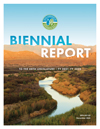Chapter 1: Agency Highlights
As the state’s environmental agency, the Texas Commission on Environmental Quality has an active presence throughout the state. Agency employees in 16 regional field offices, along with staff in its Austin headquarters, manage a variety of issues and challenges related to air and water quality, water supply, and waste management.
TCEQ takes its mission of preserving Texas’ natural resources and protecting public health very seriously and is constantly seeking new ways to improve its operations and various programs. The agency is also committed to a variety of pollution prevention initiatives and to educating Texans about what they can do to help protect the environment.
During the fiscal years of 2021 and 2022, TCEQ tackled an array of disparate challenges, from a calamitous winter storm that exposed vulnerabilities in the state’s water infrastructure to a spate of industrial accidents that demanded intensive air quality monitoring in several areas, particularly along the Gulf Coast.
The agency also undertook a series of protocols and measures to ensure a safe re-entry to normal business practices, and the associated risks, when the COVID-19 pandemic receded. As always, TCEQ’s priority is maintaining the health and safety of its employees and the public.
These and other activities take place while Texas’ population continues to increase, and its economy diversifies and expands. TCEQ has responded with initiatives that reflect changing times and new challenges—including an unprecedented turnover in the agency’s workforce—while maintaining its steadfast commitment to protecting public health and the state’s natural resources.
Leadership Changes
Chief Toxicologist
Sabine S. Lange, PH.D., DABT
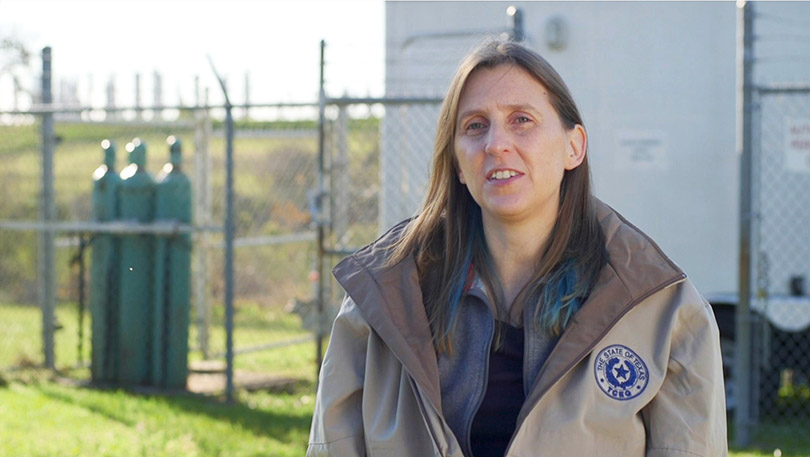
On Aug. 1, 2022, following the retirement of Dr. Michael Honeycutt, Dr. Sabine Lange was promoted to Chief Toxicologist. As the head of TCEQ’s Toxicology, Risk Assessment, and Research Division, Dr. Lange oversees health effects risk assessments of air permit applications, air monitoring data, water contamination events, toxicity factor derivation, and remediation risk assessments. She also participates in TCEQ’s response to emergencies and is a frequent commentator on a variety of high-profile issues within the news media and regulated community.
Dr. Lange has published numerous articles on a variety of research topics, including toxicology and risk assessment of air pollutants, and risk assessment methods used for derivation of toxicity factors. She also has served on several peer review committees for the U.S. Environmental Protection Agency and is a former member of the Clean Air Scientific Advisory Committee.
A native of Canada, Dr. Lange received a bachelor’s degree in biochemistry from the University of Western Ontario in Canada and completed a Ph.D. and postdoctoral training in biochemistry and molecular carcinogenesis at the University of Texas MD Anderson Cancer Center.
COVID-19
Return to Work/Hybrid Approach
It was with a sigh of relief that TCEQ leadership authorized a full reopening of agency offices on March 1, 2022, nearly two years after the outbreak of the COVID-19 virus. Leadership implemented a new workforce policy that incorporated the systemic improvements made through remote work, including more efficient electronic processes, and expanding public participation through virtual platforms. TCEQ’s adoption of a sustainable hybrid environment is designed to ensure TCEQ continues to be highly productive and accessible to the public while providing flexibility to our staff and helping TCEQ recruit and retain a diverse, well-qualified workforce.
While the COVID-19 pandemic persists, the agency continues to encourage all employees to remain informed about best practices to remain healthy. TCEQ also periodically provides onsite vaccination clinics where feasible and encourages all employees to consult with their health-care provider about vaccines.
In addition, TCEQ has resumed in-person Commission Agenda meetings and Work Sessions. The commission will continue to provide virtual participation for these meetings.
Trade Fair is Back!
After a two-year hiatus, TCEQ officially welcomed back more than 2,000 registrants to its Environmental Trade Fair and Conference on May 10-11, 2022, in Austin. Over the course of two days, agency staff led more than 100 courses and discussions, in 14 different educational tracks. Topics included air and water permitting, oil and gas, industrial and solid waste management, cs ompliance and enforcement, and remediation programs.
The exhibit hall featured booths and kiosks from more than 300 companies, as well as TCEQ’s emergency-response mobile command center and new mobile monitoring equipment, plus the agency’s Take Care of Texas program.
Also returning to an in-person event for the first time since 2019 was the annual Governor’s Texas Environmental Excellence Awards banquet. At the May 11, 2022, event, TCEQ honored an assortment of finalists and nine award winners for their achievements in environmental preservation and protection.
Since 1993, the TEEA program has honored more than 250 successful environmental projects and activities.

Emergency Response
Winter Storm Uri
The severe cold weather event, known as Winter Storm Uri, exacted a terrible toll on our state. In February 2021, extreme cold triggered massive power outages statewide, leaving millions of Texans in the cold and dark. To make matters worse, the loss of power and isolated water line breaks due to freezing temperatures meant public water systems across the state were unable to provide adequate treatment and maintain minimum pressure in their lines to safely distribute water to customers.
At its peak, the storm forced nearly 2,000 water systems to issue Boil Water Notices, affecting more than 16 million Texans.
Throughout this crisis, TCEQ staff tirelessly worked to help local officials restore potable water supplies as quickly as possible. Staff aided local officials with their emergency response efforts, provided technical expertise, and posted a toll-free number for local officials seeking labs for bacteriological testing of drinking water samples.
While the experience showed the mettle of TCEQ employees, it also revealed the need to further enhance the resilience of Texas’ critical infrastructure. With that in mind, the agency has conducted a thorough after-action review of the storm and its impact on local water systems. The goal of the initiative is to develop response and recovery actions to mitigate the risks posed by catastrophic weather-related events.
At a May 2022 work session, TCEQ staff presented a series of recommendations to the commissioners on how to improve the resiliency of public water systems and better protect critical public water system components from adverse weather conditions.
In addition to water system activities, TCEQ conducted extensive air monitoring of industrial facilities along the Gulf Coast that shut down during the storm. Regional staff monitored for volatile organic compounds, carbon monoxide, oxygen, sulfur dioxide, hydrogen sulfide, and other compounds on an as-needed basis in Houston, Beaumont, and Corpus Christi.
TCEQ also deployed mobile air monitoring vans to conduct surveys in industrial areas. In total, the vans conducted 427 air monitoring surveys covering approximately 1,240 miles through communities in Beaumont, Houston, and Corpus Christi. No concentrations of concern were measured.
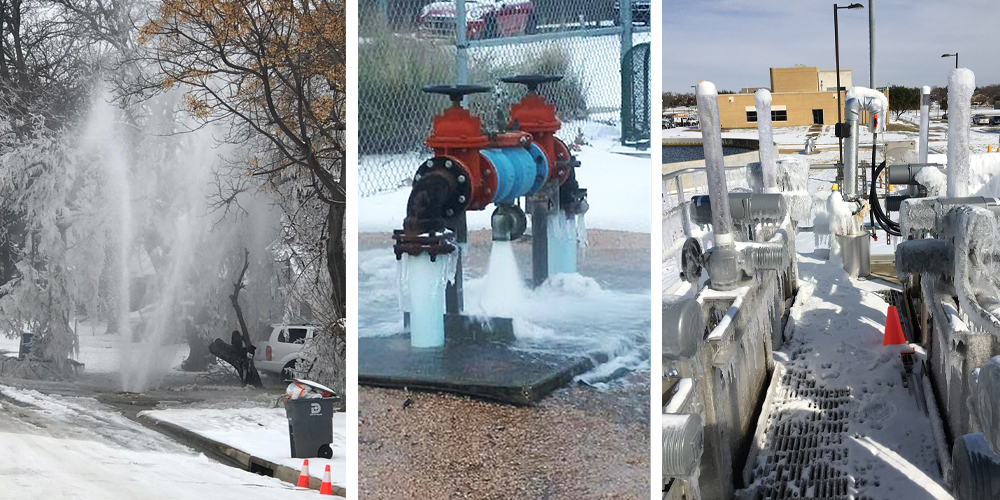
San Angelo Water Crisis
In early February 2021, the City of San Angelo notified TCEQ of residents’ complaints of foul-smelling water within its water system. TCEQ regional staff were dispatched to the area to support city officials, along with personnel from the agency’s Austin office. At TCEQ’s direction, local officials issued a Do Not Use Advisory for the entire city.
TCEQ assisted the city in an investigation that ultimately pointed to an industrial source of water contamination. Additionally, TCEQ staff coordinated with the Texas Division of Emergency Management and the Texas National Guard’s 6th Civil Support Team to assist local officials.
As part of the investigation, San Angelo officials tested water samples throughout its system, some of which revealed elevated levels of benzene. TCEQ also sampled for volatile organic compounds and semi- volatile organic compounds, including benzene.
TCEQ engineers worked with local officials to determine the source of the contamination, ultimately focusing on a faulty backflow device in an industrial zone on the outskirts of the city. City officials were able to isolate portions of its water distribution system that were not contaminated, and subsequently lifted those areas from the original Do Not Use Advisory.
As the state agency tasked with overseeing more than 7,000 public water systems across Texas, TCEQ ensures compliance with agency rules for water treatment, quality, source approval, disinfection, pressure maintenance, distribution, storage, and capacity. In general, TCEQ’s role in emergencies is to assist local systems in restoring normal operations so that residents can regain full access to their water as soon as it is safe.
TCEQ requires public water systems to comply with agency standards designed to protect drinking water. If potential hazards in a public water systems’ distribution network are not managed properly, backflow (the undesirable reversal of water flow) can allow contaminants to enter the distribution system. In these cases, TCEQ staff are available to provide technical assistance to the public water system to help them address and remediate the contamination.
In addition to maintaining adequate pressure and ensuring proper disinfectant levels throughout their distribution network, public water systems are responsible for implementing and maintaining backflow prevention and cross-connection control programs to prevent contaminants from impairing potable water supply.
Amoeba in the Water
TCEQ assisted public water systems in Lake Jackson and Arlington following the occurrence of an amoeba, Naegleria fowleri, in two separate incidents in which two children tragically died after being exposed to the microbe at splash pads.
The first incident occurred in September 2020 in Lake Jackson, Texas; the second, in September 2021, was at a city-owned park in Arlington, Texas.
Public water systems are required to disinfect water before it is available for public consumption. If there is an opportunity for Naegleria fowleri to enter a public water system’s distribution system, the system must maintain adequate disinfection levels to prevent bacteria and microbes like Naegleria fowleri from surviving.
While TCEQ regulates public water systems’ distribution networks, including oversight of the treatment and distribution of drinking water, the Texas Department of State Health Services regulates splash pads and interactive water features/fountains. Regulation of splash pads ensures they are properly operated and maintained, which includes periodic sampling of chlorine levels. Inadequate chlorine levels increases the risk of viable microbes like N. fowleri surviving.
Public water systems are required to disinfect water prior to it entering the distribution system that carries it through pipes for delivery to consumers. A public water system must be approved by TCEQ for compliance with the rules for water treatment, quality, source approval, disinfection, pressure maintenance, distribution, storage, and capacity.
Managing Water Availability During Drought
TCEQ is engaged to respond to drought. The agency’s drought response includes monitoring conditions across the state, expedited processing of drought-related water rights applications, responding to priority calls, and participating in multi-disciplinary task force meetings.
The agency also communicates information about the ongoing drought to state leaders, legislative officials, county judges, county extension agents, holders of water-right permits, and the media.
A 2015 decision by the 13th Court of Appeals in the Farm Bureau case limits the state’s power to distribute water during a drought.
Under this ruling, if TCEQ were to receive a priority call requiring suspension or curtailment to protect a senior or superior water right, the agency would be obligated to suspend junior municipal and/or power generation water rights without taking into account concerns about public health or safety.
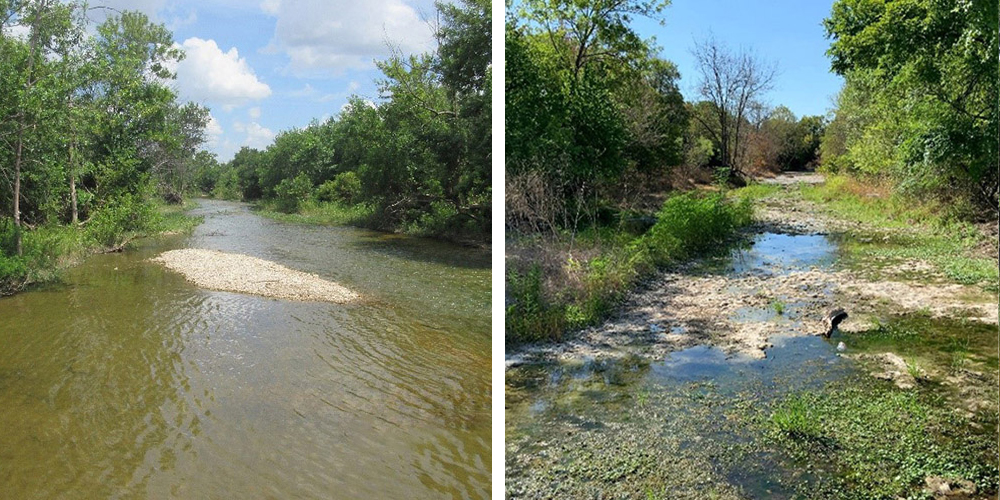
Summer 2015. At right, the same location, but Summer 2022. With the limited flow in 2022, vegetation has had
the opportunity to grow in the silt and sand accumulated in the stream bed.
Unmanned Aerial Systems
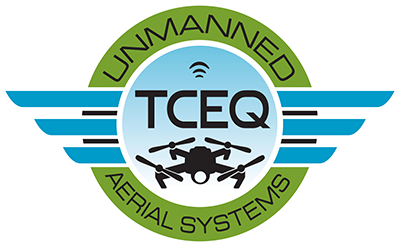
TCEQ has developed a program to provide aerial support for TCEQ personnel in the field. The Unmanned Aerial Systems (UASs) program is designed to augment the agency’s use of manned aircraft during investigations, such as aggregate production inspections in rural areas, and during emergency response events.
TCEQ possesses 42 UASs, supported by approximately 50 Federal Aviation Administration Part 107 certified pilots. The UASs and certified pilots are dispersed throughout the 16 TCEQ regional offices and at its Central Office in Austin.
At present, TCEQ uses the Drone Sense software platform to pilot, track, and maintain its UAS fleet. The platform, specifically designed for government and public-safety use, is equipped with flight control software that can be used for multiple brands and models of UASs. Drone Sense also provides flight logging, maintenance logging, and video streaming directly from the UAS cameras.
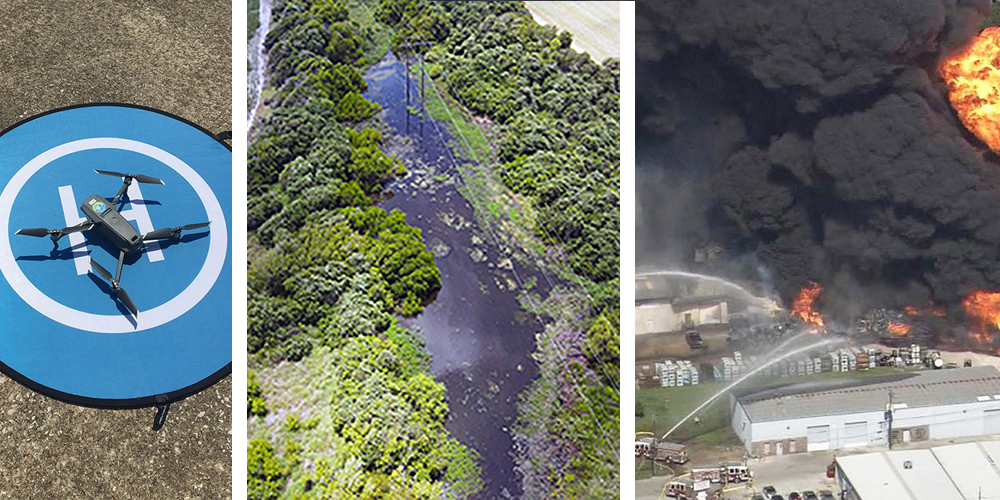
Air
El Paso Air Quality
The latest chapter in the back-and-forth legal battle over air quality standards for the El Paso area under the federal Clean Air Act continues. In February 2022, TCEQ submitted documentation to the U.S. Environmental Protection Agency to forestall a possible change in status for the area from “marginal” to the more stringent classification of “moderate.”
The crux of TCEQ’s position is that eight-hour ozone concentrations in El Paso include international emissions drifting into Texas from Mexico. If it were not for these international emissions, the agency argues, El Paso would continue to meet its current standing for ozone, and so its air quality designation should remain unchanged.
If EPA does not approve TCEQ’s preemptive move regarding the inclusion of international emissions, a reclassification of El Paso’s ozone attainment designation would require Texas to implement more stringent and costly pollution-reduction measures for the area.
Binational Air Monitoring Fund
Led by Commissioner Bobby Janecka, TCEQ was at the forefront of a binational effort to address air pollution throughout the El Paso Air Basin with the creation of an innovative new source of funding for continuous air-quality monitoring.
The Binational Air Monitoring Fund finances projects to ensure ongoing measurement of air quality within the basin, a desert region defined by the Rio Grande and mountainous terrain that encompasses two countries, three states, several cities, a federally recognized Native American tribe, and some 2.7 million people.
Data derived from continuous air monitoring helps identify sources of emissions, essential to targeting containment strategies and investment in effective pollution controls. The fund will finance air quality projects throughout the region, with particular focus on reestablishing air monitoring stations in Ciudad Juárez, Chihuahua, Mexico, where generation of reliable data has suffered from sporadic funding and inadequate maintenance of equipment.
Texas Emissions Reduction Plan (TERP)
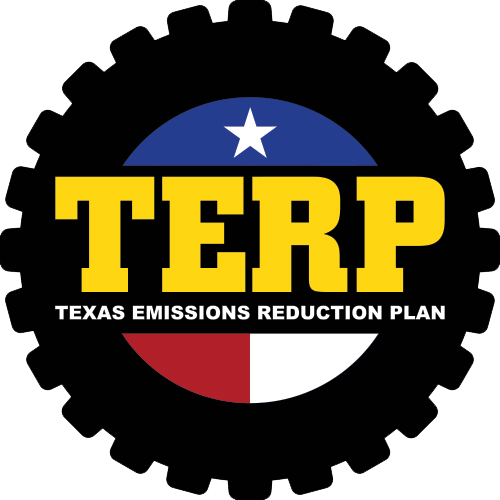
TCEQ’s Texas Emissions Reduction Plan (TERP) program continues to be an important tool for reducing air emissions from vehicles and equipment operating in Texas. TERP also encourages the use of alternative fuels for transportation and supports new and innovative technologies for reducing emissions from stationary sources.
Some of the key program highlights through August 2022:
-
Since 2001, the TERP programs have reduced 192,567 tons of NOX in Texas.
-
Since 2001, the Diesel Emissions Reduction Incentive Program has awarded more than $1 billion in grants to replace or upgrade more than 20,472 vehicles and pieces of equipment.
-
Since 2005, the Texas Clean School Bus Program has awarded more than $48 million in grants for the retrofit or replacement of 7,857 school buses.
-
Since 2009, the Texas Clean Fleet Program has awarded more than $69 million in grants to replace 730 vehicles with hybrid or alternative fuel vehicles.
-
Since 2010, the New Technology Implementation Grant Program has awarded more than $12 million in grants for projects with potential to reduce emissions from stationary sources and projects to store and distribute electricity from renewable sources.
-
Since 2012, the Texas Natural Gas Vehicle Grant Program has awarded more than $54 million in grants to upgrade or replace 1,892 vehicles with natural gas vehicles.
-
Since 2012, the Alternative Fueling Facilities Program has awarded more than $31 million in grants to establish or upgrade 311 natural gas, alternative fueling, or electric charging facilities in the Texas Clean Transportation Zone.
-
Since 2014, the Light-Duty Motor Vehicle Purchase or Lease Incentive Program has awarded more than $15 million in rebates for the purchase or lease of 6,574 electric and natural gas vehicles.
-
Since 2015, the Seaport and Rail Yard Areas Emissions Reduction Program has awarded more than $28 million in grants to replace 343 drayage trucks and pieces of cargo-handling equipment operating at seaports and rail yards in Texas.
-
Since 2018, the Port Authority Studies and Pilot Programs has awarded more than $2 million in grants for port authorities to conduct studies and implement pilot programs for incentives to encourage cargo movement that reduces emissions.
-
Since 2021, the Governmental Alternative Fuel Fleet Program has awarded $6 million in grants for state agencies and political subdivisions to upgrade, replace, or expand their vehicle fleets to alternative fuel, and to purchase, lease, or install refueling infrastructure for those vehicles.
Sunset Commission Report
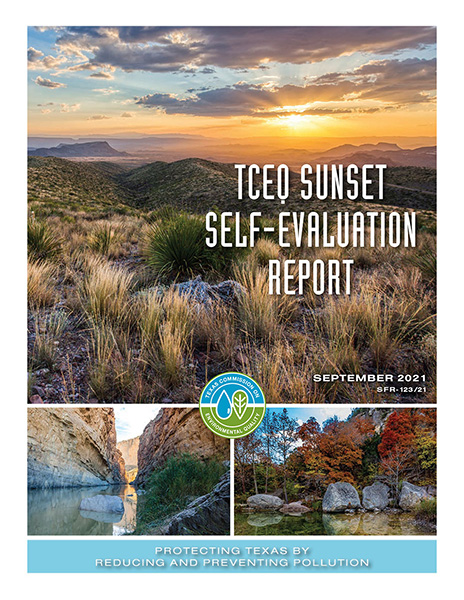
TCEQ is under review for the 2022-23 review cycle of the Sunset Advisory Commission. The process included TCEQ submitting a Self-Evaluation Report, meetings between Sunset staff and TCEQ staff, and requests for information by Sunset staff. In the Self-Evaluation Report, TCEQ reported major issues concerning funding for small water systems, revenue shortfall in the Waste Management Account, workforce challenges, virtual meetings, and electronic access to permit documents.
During this process, between October 2021 and March 2022, TCEQ met with Sunset staff more than 50 times and responded to more than 250 requests for information. In addition, Sunset staff conducted site visits at TCEQ regional offices in Austin, Houston, San Antonio, and the Dallas/Fort Worth area.
Based on this information and discussions with other interested parties, including the public, the Sunset staff issued its report, which included five issues and 20 recommendations requiring management action and statutory changes. Sunset staff recommended continuation of the agency for an additional 12 years.
Sunset staff identified transparency and meaningful public input as areas that need improvement. Some related recommendations for this include a statutory clarification to require TCEQ to hold public meetings before and after draft permit issuance, and management actions requiring the commission to vote in a public meeting on key foundational policy decisions and to develop a guidance document explaining how it makes affected person determinations.
Another issue identified by Sunset staff provides that TCEQ’s compliance monitoring and enforcement processes need improvements to hold regulated entities consistently and equitably accountable. For example, Sunset staff recommended that TCEQ’s compliance history rating formula consider all evidence of noncompliance, and decrease emphasis on site complexity. It also directed the agency to consider all violations when classifying an entity as a repeat violator, to require annual confirmation of operational status of entities with temporary or open-ended permits, and to reclassify recordkeeping violations based on the potential risk and severity of the violation.
Sunset staff also identified water resources as an area that needed statutory changes, including: removal of the abolishment clause in the E-flows advisory group and its science advisory committee so that they could remain in existence, adding a requirement that the E-flows Advisory Group adopt a biennial statewide work plan for adaptive management updates of environmental flow standards, and a requirement that TCEQ hold its annual meeting regarding priority groundwater management area studies in a public setting. Sunset staff further made a management recommendation that TCEQ conduct a comprehensive study of its water usage data and initiate cancellation proceedings for water right permits with nonuse over 10 years.
Sunset staff presented their recommendations during a meeting of Sunset Advisory Commission members, at which TCEQ had an opportunity to respond and address the members’ questions. At the same meeting, the public and interest groups also presented their comments and concerns to the Sunset Commission members. Final recommendations by the Sunset Advisory Commission will be presented in November 2022.
In the upcoming session, the Legislature will consider these recommendations and make final decisions. While awaiting further direction from the Sunset Advisory Commission meeting in November, as well as any direction from the Legislature in the form of statutory changes made in the upcoming legislative session, the agency is in the process of implementing certain management actions.

